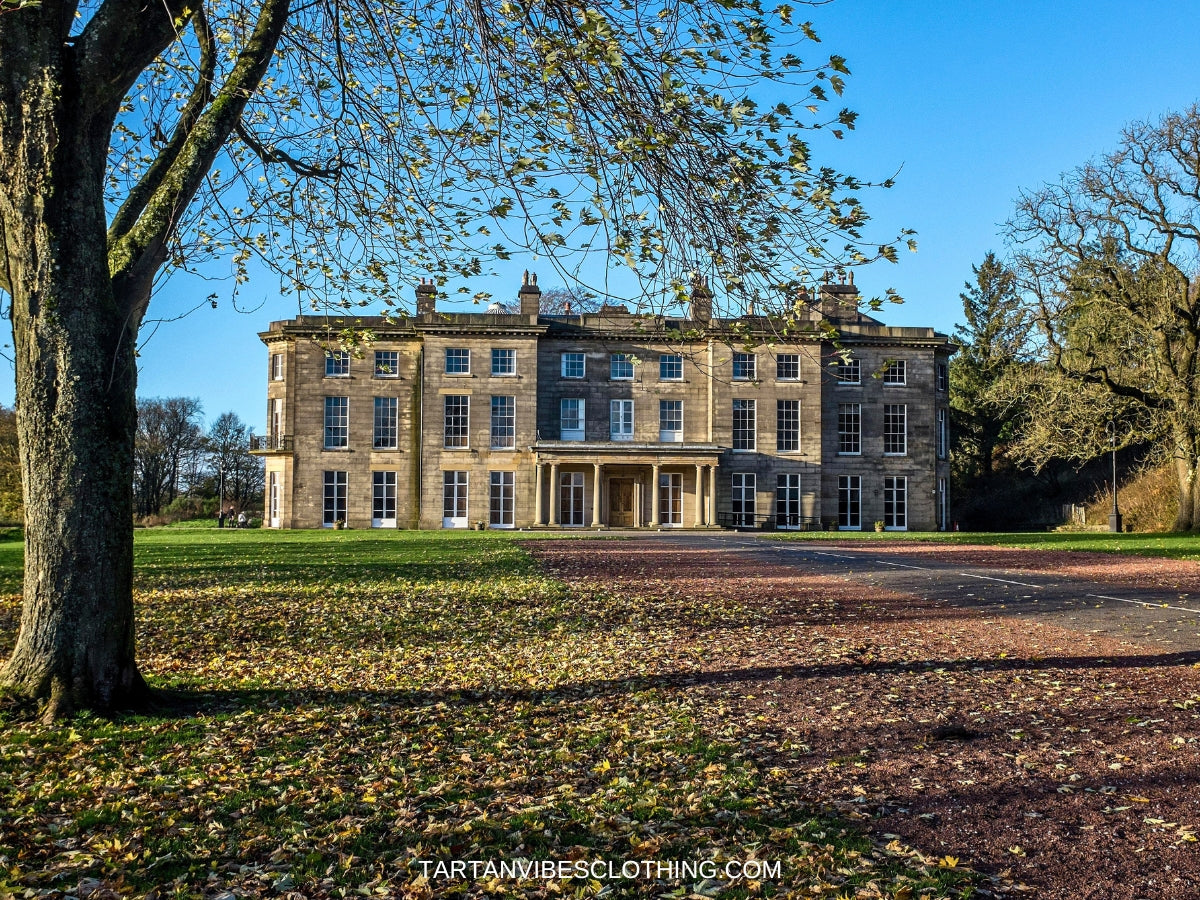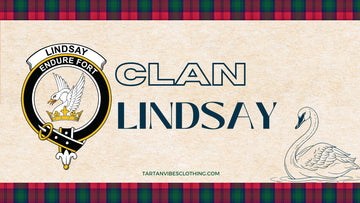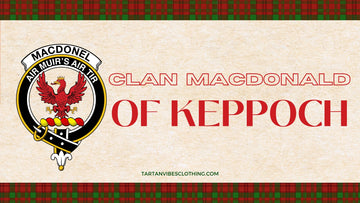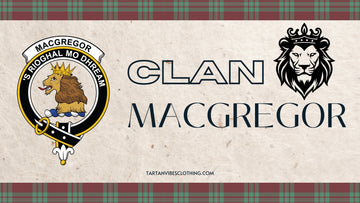Unveiling Clan Lindsay's Legacy: Enduring Scottish Clan
by Teejay Smith on Apr 19, 2024
Table of Content
Welcome to the enthralling saga of Clan Lindsay, a name synonymous with Scottish history. Their roots trace back to the 11th century, intertwining their lineage with the nation's very fabric. Renowned for their strength and unwavering spirit, the Lindsays played a crucial role in shaping Scotland's destiny. From their early origins to their pivotal contributions during the Wars of Independence, Clan Lindsay's legacy continues to resonate. This exploration delves into their ancestral lands, majestic castles, and enduring character, unveiling the secrets that forged a clan forever etched in Scottish legend.
I. Origins of Clan Lindsay
The Clan Lindsay's origins trace back to the 11th century, rooted in the region of Lindsey in England. After the Norman Conquest of 1066, the Lindsays established themselves in Britain. Sir Baldric de Lindsay was documented as a landholder in the Domesday Book 1086.
By the 12th century, the Lindsays had crossed the border into Scotland, acquiring lands in the Scottish Borders. Their connection to Scottish royalty began early, with Sir Walter de Lindsay serving as King David I's court member. This close relationship solidified over generations, with David Lindsay of Crawford attaching his seal to the Declaration of Arbroath, a pivotal document asserting Scottish independence in 1320. The Lindsays' early rise and establishment in England and Scotland laid the foundation for their enduring presence and influence in Scottish history.
II. Territory of Clan Lindsay

III. Clan Lindsay History

Early History (11th - 13th Centuries)
In the early 12th century, the Lindsays began establishing themselves in Scotland, accompanying David of Scotland, Earl of Huntingdon, in his claim to the Scottish throne. William de Lindsay, son of Sir Baldric, played a significant role, sitting in the Parliament of 1164 and later serving as a justiciar. The family's territorial holdings expanded, with William de Lindsay acquiring the lands of Crawford and Luffness.
Wars of Scottish Independence and 14th Century (14th - 15th Centuries)
During the Wars of Scottish Independence, Clan Lindsay became deeply involved in the struggle for Scottish sovereignty. David Lindsay, grandson of William Above de Lindsay, added to the family's prestige by appending his seal to the Declaration of Arbroath in 1320, asserting Scotland's independence to the Pope.
The 14th century saw the Lindsays rise to prominence. Sir David Lindsay famously participated in a tournament at London Bridge in 1390. His victory at the game earned him the admiration of King Richard II of England and led to his creation as Earl of Crawford in 1398. The Lindsays continued to play crucial roles in Scottish affairs, with notable figures like Alexander Lindsay, 4th Earl of Crawford, joining rebellions against Scottish monarchs.
The Scottish Renaissance and Reformation (16th - 17th Centuries)
Jacobite Risings and Modern Era (18th Century - Present)
The 18th century brought challenges for Clan Lindsay during the Jacobite risings, with members of the family divided in their loyalties. While some, like John Lindsay, 20th Earl of Crawford, supported the British Government, others, such as Colin Lindsay, 3rd Earl of Balcarres, were staunch Jacobites.
Clan Lindsay continues to uphold its traditions and heritage in the modern era. The earldom of Crawford eventually passed to the Earl of Balcarres, uniting the titles in the 19th century. Today, the legacy of Clan Lindsay endures, with descendants preserving their ancestral ties and contributing to Scottish culture and society.
📜 Please also see the history at https://www.clanlindsay.org.au/lindsay.htm
IV. Clan Lindsay Castle
Balcarres House: A Seat of Power and Prestige

Balcarres House, the current residence of the Clan Lindsay Chief, offers a fascinating blend of history and grandeur. Built in 1595 by John Lindsay of Balcarres, it was a dual seat – the home of the Earl of Crawford and the Clan Lindsay head. While retaining its 16th-century core, the house underwent significant 19th-century renovations, transforming it into the impressive structure it is today. Balcarres House is a protected Category A listed building recognized for its historical significance. Its surrounding grounds are included on the Inventory of Gardens and Designed Landscapes in Scotland.
Edzell Castle: A Legacy of Beauty and Intrigue

Edzell Castle stands as a testament to Clan Lindsay's architectural prowess. This magnificent structure, originally a medieval motte and bailey, was transformed into a grander castle around 1520 by David Lindsay, 9th Earl of Crawford. Further additions by his son, Sir David Lindsay, Lord Edzell, solidified the castle's grandeur. Notably, Lord Edzell also created the beautiful walled garden, which continues to impress visitors today. Unlike many Scottish castles, Edzell Castle remained largely unscathed by battles, contributing to its exceptional state of preservation. Today, the castle and garden are managed by Historic Environment Scotland and open to the public.
Luffness Castle: A Fortress Steeped in History

Craigie Castle: Ancestral Home Steeped in Legend

V. Clan Lindsay Coat Of Arms

The Clan Lindsay Coat of Arms, a visually captivating emblem, reflects the clan's rich history and lineage. Divided into four quadrants, each section narrates a distinct aspect of their heritage.
The Lindsay Legacy (1st & 4th Quadrants)
Gules (red) fields decorated with a "fesse, chequy, Argent and Azure" (a horizontal band of alternating silver and blue squares) dominate the first and fourth quadrants. This chequy pattern, a hallmark of the Lindsays, represents their lineage and heritage.
The Abernethy Alliance (2nd & 3rd Quadrants)
The second and third quadrants showcase a contrasting design. A gold (Or) background features a rampant red lion (lion rampant, Gules) adorned with a black ribbon (sable). This symbolism represents the Abernethy family, with whom the Lindsays formed a powerful alliance.
A Unifying Symbol
With its combined elements, the Clan Lindsay Coat of Arms embodies their lineage, strength, and the enduring nature of their alliances. It is a unifying symbol for clan members, reminding them of their shared heritage and values.

VI. Clan Lindsay Crest
Gaelic Name: MacGhille Fhionntaig
Crest: Issuing from an antique ducal coronet Or, the head, neck and wings of a swan, Proper
Motto: Endure forte (Suffer bravely)
Origin of Name: Placename, probably Norman
Badge: Rue
Lands: Borders, Angus
Clan Chief: The Rt. Hon. The Earl of Crawford

The Clan Lindsay Crest, a potent emblem rising from a golden ducal coronet, embodies the clan's values and heritage. This single element, a majestic swan depicted in its natural white ("proper"), speaks volumes about the clan's identity.
The Swan: A Symbol of Grace and Watchfulness
The Ducal Coronet: A Sign of Nobility
The golden ducal coronet, from which the swan emerges, signifies the clan's lineage and noble heritage. It represents their long history and distinguished standing within Scottish society.
VII. Clan Lindsay Plant Badge
The Lime Tree, Clan Lindsay's plant badge, is more than a decorative emblem. It symbolizes their deep connection to their ancestral lands in Fife, Scotland. Balcarres House, the clan's seat, boasts a majestic avenue of lime trees stretching towards the village of Colinsburgh. This living testament embodies the clan's heritage and enduring spirit.
The choice of the Lime Tree is not merely symbolic. Renowned for their resilience, these trees mirror the unwavering spirit of the Lindsays. Additionally, lime trees often grow in grand avenues, reflecting the clan's values of unity and community.
VIII. Clan Lindsay Tartan
The Clan Lindsay Tartan is a distinctive and traditional pattern that holds deep significance for members of the Lindsay family. This recognizable tartan features a rich tapestry of colors, primarily consisting of deep green, blue, black and white.






Colors Steeped in Symbolism
- Green: The dominant green represents the lush landscapes of Scotland, symbolizing the clan's connection to their ancestral lands.
Blue: Shades of blue evoke Scotland's clear skies and flowing waters, reflecting a sense of peace and perseverance.
Black: Black adds depth and contrast to the design, signifying strength and resilience.
White: White lines accentuate the design, adding brightness and purity, representing honesty and integrity.
A Unique Design and Enduring Legacy
Wearing Your Heritage
Beyond traditional kilts, the Clan Lindsay Tartan finds expression in various casual clothing, offering a stylish way to showcase your heritage. From cozy flannel shirts and trendy scarves to classic tartan skirts, incorporating this distinctive pattern into your wardrobe adds a touch of Scottish tradition to your everyday look
Unlike the patterned richness of the Clan Lindsay Tartan, the Clan Stewart Tartan boasts a more spartan elegance. This distinct color palette, featuring bold red, black and white, reflects a sense of strength, determination and unwavering loyalty – values deeply ingrained in the clan's history.
Explore the timeless traditions of the Lindsay Clan through our collection of tartan products on our website. And bring a piece of the clan's history into your present.
IX. Clan Lindsay Chieftaincy
Sir Robert Alexander Lindsay, the current Clan Chieftain, leads the esteemed Clan Lindsay. He holds the prestigious titles of 29th Earl of Crawford and 12th Earl of Balcarres, solidifying his lineage as a Scottish hereditary peer. Sir Robert's dedication extended beyond the clan, as he served as a Conservative politician and Member of Parliament from 1955 to 1974. His contributions have been recognized through several distinguished honors, including Privy Counsellor (1972), Knight of the Thistle (1996) and Knight Grand Cross of the Royal Victorian Order (2002).
X. The Famous People of Clan Lindsay
Clan Lindsay boasts a rich tapestry of prominent figures who have left their mark across various eras. This list highlights some remarkable Lindsays:
Sir David Lindsay (1st Lord Lindsay of Balcarres): From the late 16th to mid-17th centuries, Sir David was a key figure in Clan Lindsay's history. Knighted for his achievements, he established the prestigious Lindsay lineage as the 1st Lord Lindsay of Balcarres.
Alexander Lindsay (2nd Lord Balcarres & 1st Earl of Balcarres): Following his father's footsteps, Sir David's son, Alexander, became the 2nd Lord Balcarres and was further elevated to 1st Earl of Balcarres. Their prominence reflects the Lindsays' thriving status in early modern Scotland. This legacy continues today as the current Clan Lindsay chief holds these titles.
Colin Lindsay (3rd Earl of Balcarres): Taking on the mantle of Earl after his brother's passing, Colin played a pivotal role in history. Fighting alongside the future King James II at the Battle of Solebay (1672), his loyalty was awarded with prestigious positions like treasury commissioner and Lord Lieutenant of Fife.

Kara Lindsay: Hailing from Rochester, NY, Kara Lindsay is a shining example of the Lindsays' enduring talent. This renowned Broadway actress has graced stages in productions like "Newsies", "Beautiful: The Carole King Musical," and "Wicked". Her alma mater, Carnegie Mellon University, was founded by the famous Scot, Andrew Carnegie.

- Howard Lindsay: Born Herman Nelke, Howard Lindsay rose to fame under his stage name as an American theatrical powerhouse. Part of the acclaimed writing duo "Lindsay and Crouse," he co-created the iconic musical "The Sound of Music" with Rodgers and Hammerstein. His contributions garnered prestigious awards like the Pulitzer Prize for Drama and Tony Awards, bringing honor to the Clan Lindsay name even from his base in New York.

XI. Clan Lindsay Pipe Band

Fueled by a passion for Scottish heritage, the Clan Lindsay Pipe Band emerged in Greensboro, North Carolina, in August 2010. Led by Clan member Mark Elliott, the band aimed to promote piping and drumming traditions. Backed by Clan Lindsay USA, they officially formed in February 2011.
Early success followed, with a well-received debut and a remarkable first-place finish at the Stone Mountain Highland Games that same year. Their talent was further recognized by an upgrade to Grade 4 by the EUSPBA. However, maintaining consistent membership proved challenging. Despite dedicated efforts and impressive performances, the band disbanded in 2012 due to a lack of participation.
Though short-lived, the Clan Lindsay Pipe Band's story reflects the dedication and talent of its members. Their passion for Scottish music and heritage left a lasting impression, even if their journey was cut short.
XII. The Clan Lindsay Society
The Lindsay name resonates with a rich history and a strong sense of community fostered by various Clan Lindsay societies across the globe. Here's a glimpse into some prominent organizations:
The Clan Lindsay Society (Scotland): Established in 1897 in Edinburgh, this esteemed society serves as the heart of the global network. Their core mission is to reunite and connect descendants of the Lindsay Clan. They achieve this through annual meetings, participation in clan gatherings and initiatives like the ongoing Glasclune Monument Project.
Membership and Activities: Open to all Lindsays by blood or marriage, the society welcomes anyone connected to the clan lineage. Their activities extend beyond reunions, with support for genealogical research and engagement in projects of historical significance.
Global Reach of the Lindsay Name:
Clan Lindsay Society of Australia
Clan Lindsay Society of New Zealand
The Lindsay Family Association of America Inc.
The Linzee Family Association of America
XIII. Conclusion
In summary, Clan Lindsay stands as a testament to the rich tapestry of Scottish history, with their roots stretching back centuries. From their origins in Lincolnshire to their influential presence in Scotland, the Lindsays have embodied resilience, strength and a deep connection to their ancestral lands.
Beyond their prowess on the battlefield, the Lindsays have made significant contributions to Scotland's cultural heritage, leaving a lasting legacy in music, poetry and craftsmanship. Today, the global network of Clan Lindsay societies serves as a beacon of unity, preserving and celebrating the enduring spirit of the clan for generations to come.
Frequently Asked Questions
What clan does Lindsay belong to?
Clan Lindsay is a Scottish clan of the Scottish Lowlands. Crest: Issuing from an antique ducal coronet the head neck and wings of a Swan proper.
Where is Clan Lindsay from?
Clan Lindsay developed on both sides of the border with the first Lindsay recorded in Scotland in 1120. The family prospered both in England and Scotland which, when the Scottish Wars of Independence came around, the Family had to divide its lands and give up the English portion.
Is there a Clan Lindsay tartan?
The Lindsay tartan is immediately recognisable from its deep green and maroon colors. Although it is a clan tartan, its unique aesthetic makes it a popular choice for clothes and interiors. The Lindsay tartan is immediately recognisable from its deep green and maroon colors.
Who were the Lindsay clan's enemies?
At the Battle of Arbroath in 1445 the Clan Lindsay, led by the Master of Crawford, advanced with over 1000 men. Their enemy was the Clan Ogilvy who were also supported by men from the Clan Oliphant, Clan Gordon, Clan Seton and Clan Forbes of Pitsligo.





